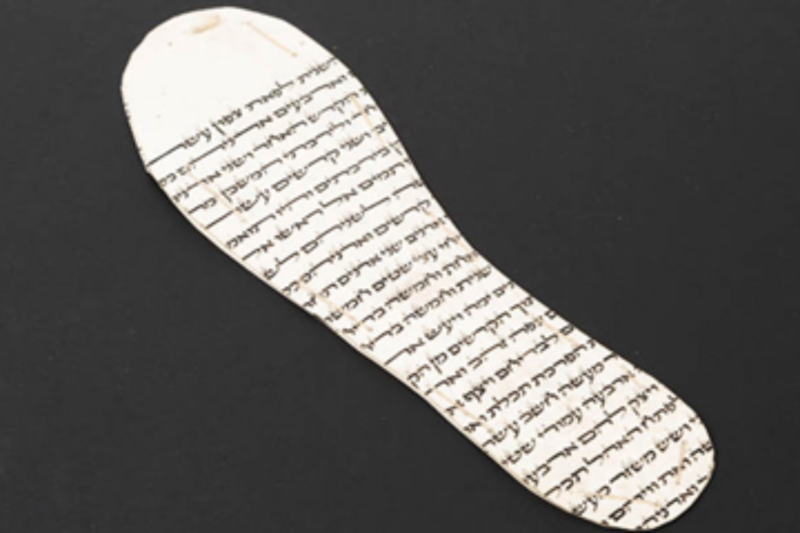Shoe soles cut from a Torah reveal clues about Nazi-occupied Greece

Image: University of Leeds
Children’s shoe soles cut crudely from the Jewish Torah could reveal chilling clues about Nazi-occupied Greece, according to new research by the University of Leeds.
The Sefer Torah is a sacred Hebrew scroll handwritten on animal parchment and read weekly in synagogues – so precious that Judaism forbids touching it with bare hands – but in post-Holocaust Greece, historian Cecil Roth discovered a pair of children’s shoe soles cut from the holy text.
New research published today in Holocaust Studies has uncovered that the Hebrew script on the soles is about another exile of the Jewish people – and this was probably the last passage read at Synagogues before thousands of Greek Jews were deported to Auschwitz-Birkenau in the Holocaust.
The study author, Dr Jay Prosser, a Reader in Humanities, said: “It is important to research artefacts like this because objects connect us to the personal stories of the past in a way that facts and figures often can’t. These relics, both sacred and sacrilegious at the same time, symbolise the holiest text of Judaism being trodden underfoot.”
The left sole is housed in the University of Leeds Special Collections as part of the Roth Collection, acquired after Roth’s death in 1970.
An “uncanny relic” of the Holocaust in Greece
The Nazis invaded Greece in 1941 and nearly eradicated its Jewish population, with a devastating 84% death toll. Many Greek Jews were deported to Auschwitz-Birkenau in 1943-44 and during this time members of the remaining Greek population looted what the Nazis didn’t claim.
The use of the scroll for the shoe sholes shows a lack of basic resources in Greece under Nazi rule, as well as the decimation of Jewish culture in the country.
The script on the soles describes the building of the mishkan (the ark or tabernacle) during the exile of the Israelites in the wilderness, creating an unsettling parallel with the deportation of Sephardi Jews from Greece.
According to the research, it is likely this was the last passage read at Greek Synagogues before they were deported by the Nazis, making the soles a chilling reminder of the long global history of antisemitism.
Dr Prosser said: “That the soles are small and likely to have been intended for a child’s shoes adds to their poignancy, the sad and searing feeling they induce of vulnerability, innocence, and inexplicable loss in the face of massive destruction.”
The Roth Collection
Many questions remain around how, when and why Roth found these soles and chose to take them for his collection, as Roth’s records on his collecting are unspecific.
The eminent Jewish historian co-founded the London Jewish Museum and was the chief editor of the first Encyclopaedia Judaica.
Dr Prosser argues that Roth probably found them in Arta – not the large Greek Jewish community in Salonica, known before the war as the ‘Jerusalem of the Balkans,’ as previously thought.
Thanks to a generous grant from the Rothschild Foundation Hanadiv Europe, the Roth Collection at the University was catalogued for public access in 2019, enabling this new research.
The right sole is kept in Canada but has recently been purchased as part of the Beth Tzedec Collection by the Royal Ontario Museum, but it is currently unviewable because of the pending move, according to the paper.
Sharing the story
The research is now calling for both soles to be digitised and cross-referenced so further research can be carried out into where and when this Sefer Torah was created and what synagogue it was taken from.
Based at the University’s School of English, Dr Prosser mainly teaches creative writing, specialising in memoir. In his next project, Dr Prosser intends to delve deeper into the story of the shoe soles in a work of creative memoir, imagining the parts of this story that can’t be filled in with historical evidence.

 China
China